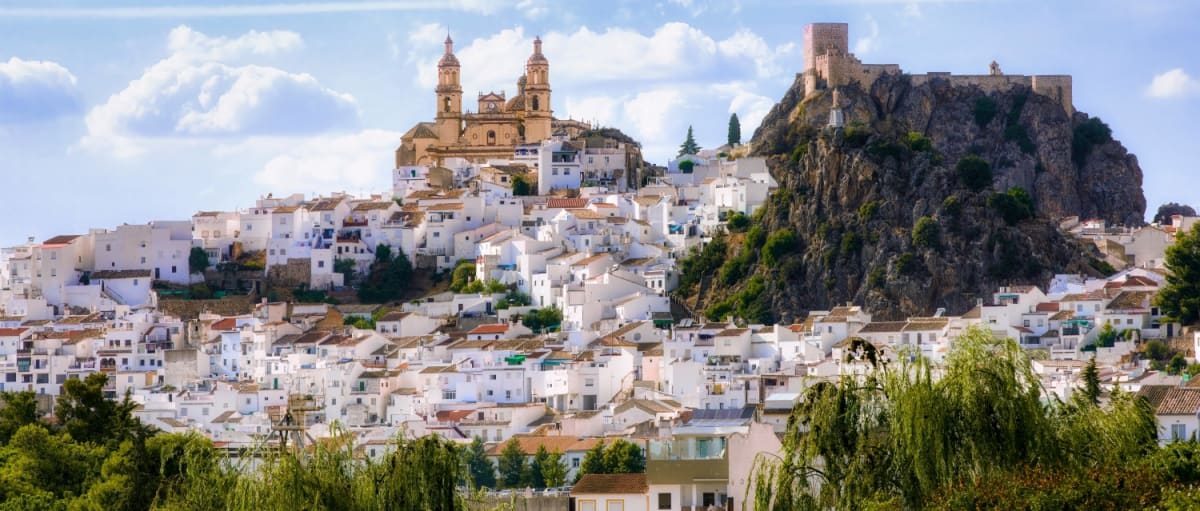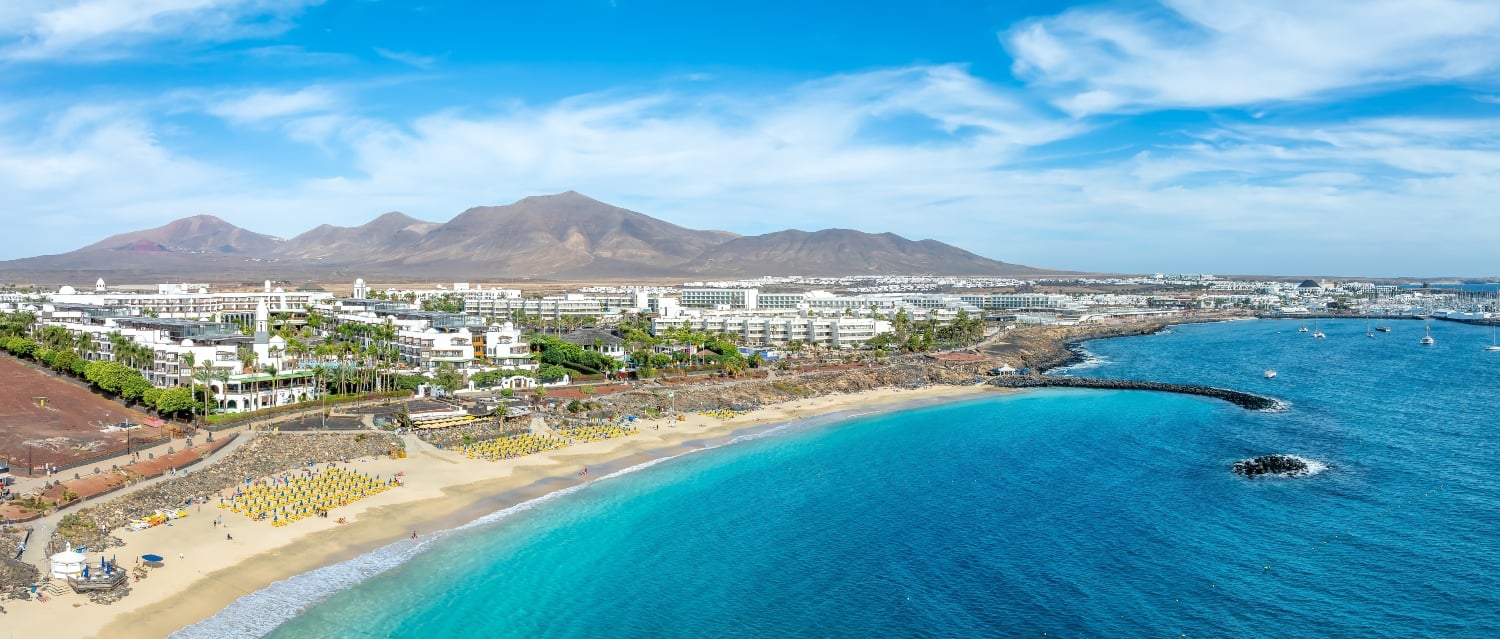Year-round sunshine, low purchase taxes and a protected natural landscape make Lanzarote one of the most appealing places to buy property abroad. Here’s everything you need to know about buying there…
Lanzarote’s first impression can be deceptive. As you drive away from the airport, the volcanic plains might feel stark and treeless. But before long, the island’s unique beauty takes hold – with whitewashed homes dotting the lava fields, terraced vineyards springing up from black volcanic soil and golden beaches framed by the Atlantic’s rhythmic surf. Add in thoughtful architecture, warm winter weather and a relaxed pace of life, and you’ll quickly see why many overseas buyers fall for Lanzarote.
Download the Spain Buying Guide
Contents
Why buy property in Lanzarote?
Part of the Canary Islands, Lanzarote sits just off the north-west coast of Africa, meaning its climate is far more consistent than mainland Spain’s. It’s also less built up – largely thanks to the influence of artist César Manrique, who championed sustainable, traditional architecture. Planning laws still reflect this, limiting buildings to three storeys and requiring the classic white exteriors and green or blue shutters you’ll see island wide.
For property buyers, that means two key things: a timeless, harmonious look across towns and villages, and a limited supply of homes – which helps protect long-term value. Lanzarote is also a great option for anyone prioritising low-maintenance living and natural beauty. It’s ideal if you love:
- Easy access to beaches and warm weather throughout winter
- Outdoor living – think golf, hiking, cycling and water sports (especially surfing)
- A supportive expat and holiday-homeowner community
- A calmer alternative to busier islands like Tenerife or Gran Canaria
What’s the weather like?
Consistent sunshine is one of Lanzarote’s biggest attractions. You can expect over 300 sunny days per year, with mild winters and warm summers. The hottest months are July and August, when temperatures reach around 30°C, though Atlantic breezes prevent it from feeling oppressive.
In winter, average highs hover around 20-21°C, making Lanzarote a popular retreat for those looking to escape colder climates. Rainfall is minimal – with just 20 days of rain a year – and even when it does rain, it tends to clear quickly. Sea temperatures are cooler than the Mediterranean but still comfortable for swimming all year round.
How to get there
Lanzarote is very accessible from the UK and much of Europe. Flights take around four hours from London, with daily routes from most major airports. The airport, César Manrique-Lanzarote Airport, is located near the capital Arrecife and only a short drive to the island’s popular resorts.
Inter-island ferry services are also available – including a 30-minute crossing to Fuerteventura – making island-hopping easy. While a car isn’t strictly necessary if you’re based in a resort, it does give you the freedom to explore more rural areas.
Where to buy in Lanzarote
The island is just 60 kilometres by 25 kilometres, so no matter where you buy, you’re never far from the coast. But each area offers something slightly different:
- Puerto del Carmen: Buzzing and beachy, with a large expat population, good nightlife and reliable rental potential.
- Playa Blanca: More relaxed than Puerto del Carmen, popular with families and retirees, and home to some of the island’s best sea-view villas.
- Costa Teguise: Great for windsurfing, families and long-stay visitors. This area is well-connected and walkable, with beaches, shops and schools.
- Arrecife: The capital has a more traditional, local feel. It’s small, practical and growing in popularity with buyers seeking a slice of “real” Lanzarote life.
- Haría and the north: For those who want peace and tradition, the villages of the north offer authenticity and affordability – though you’ll need a car to get around.
What property costs
Prices in Lanzarote are generally lower than in parts of southern mainland Spain, but limited supply means the best properties can sell quickly. Here’s what different budgets will typically buy:
| Budget | What you can buy | Popular locations |
|---|---|---|
| Up to €150,000 | Compact one-bedroom apartment | Costa Teguise, Arrecife |
| €230,000-€300,000 | Two-bedroom villa or townhouse | Puerto del Carmen, Playa Blanca |
| €450,000+ | Detached villa with pool and sea views | Playa Blanca, countryside locations |
Can you live there full-time?
Absolutely – Lanzarote isn’t just for holidays. Many British and European nationals live here permanently or spend large parts of the year on the island. The infrastructure is solid, with international schools, healthcare centres, good roads and plenty of support services for new arrivals.
If you’re planning a permanent move post-Brexit, you’ll need to apply for a visa or residency permit. Most second-home buyers spend up to 90 days at a time under the Schengen rules, but long-term stays will require additional paperwork. Your lawyer or relocation advisor can help with this.

Is Lanzarote a good investment?
For the right buyer, yes. Property in Lanzarote tends to hold its value well thanks to strict planning laws and limited land. The resale property tax (TPI) is just 6.5%, significantly lower than the 10% applied in many mainland regions like Valencia or Andalusia.
Lanzarote attracts over 3m tourists per year, and with strong demand in both summer and winter months, holiday rentals remain a viable option – particularly in resorts like Puerto del Carmen and Playa Blanca. However, local rules around short-term rentals are evolving, so always check licensing requirements before you buy with rental income in mind.
How to buy a home in Lanzarote
Here’s a simplified step-by-step guide to buying in Lanzarote:
- Start your research
Shortlist properties that match your goals – be it rental potential, outdoor lifestyle or long-term living.
- Build your team
Appoint an independent Spanish-speaking lawyer, plus a local agent, currency specialist and mortgage broker if needed.
- Book a viewing trip
It’s best to view homes in person, but you can also arrange virtual tours in the early stages.
- Make an offer
Once accepted, pay a reservation fee to secure the property and begin legal checks.
- Sign the contract and pay a deposit
Typically 10% of the purchase price. At this stage, you should fix your exchange rate.
- Complete the purchase
Sign the final sale contract (escritura) at the notary’s office, pay the balance and associated fees – and receive your keys.
FAQs about buying property in Lanzarote
Yes. UK citizens can legally buy property in Lanzarote just like any other foreign national. Since Brexit, the main difference is that you’ll need to apply for a visa or residency permit if you want to live on the island full-time. For holiday homes or part-time living, you can spend up to 90 days in a 180-day period.
Lanzarote is considered a strong choice for buyers thanks to its strict planning rules, limited housing supply and year-round appeal. Properties tend to hold their value well, and with over 3m tourists visiting annually, rental demand is strong – especially in resorts such as Puerto del Carmen and Playa Blanca.
Owning property doesn’t automatically grant residency. As a UK citizen, you can stay up to 90 days in every 180-day period without a visa. If you plan to live in Lanzarote permanently or for extended periods, you’ll need to apply for a Spanish residency permit that suits your circumstances.
Speak to a Spain property expert
You might also like:









